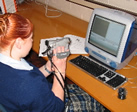Primary 1
The web links in this document require the RealPlayer plug-in. (RealPlayer clips will not store offline.) You might also like to explore CLEO MagicWall, which offers pages from the resource mentioned in this article, in a format that can be downloaded for use with a digital projector, with or without an electronic whiteboard.
As part of a unit of work with Year 6 on major inspirational religious figures in both Christianity and Buddhism, a teacher used a free online resource called 'Draw the Buddha's Face' to explore the key question, 'What can we learn about inspirational religious figures from the way artists represent them?' The resource includes video sequences that show artist Andy Weber sketching, in traditional Tibetan Buddhist style, a head of the Buddha. Clear instructions accompany each video clip, and straightforward information panels explain what is being shown.
There was an interactive whiteboard in the main classroom and the pupils had access to a cluster of computers in an adjacent work area.
The teacher started the lesson by displaying a presentation slide showing three images of the head of Lord Buddha from different cultural traditions within Buddhism. In pairs, pupils were given five minutes to identify as many similarities and differences as they could. The suggestions they fed back to the class included the hair knot, elongated ear lobes, a mark between the eyebrows and half-shut eyes.
Pairs then joined up to form fours to generate questions about the pictures, which they would want to find answers to during the lesson. The teacher recorded these questions on the board, without comment, for use in the plenary.
Then, with the attention of the class focused on the interactive whiteboard, the teacher explained that their task was to work in pairs to produce a drawing of the head of the Buddha by following the online instructions (Step 3 of the resource). He then demonstrated how to access the resource from a link on the computer (a method familiar to pupils) and how to navigate the resource to work on the task. A template (downloaded from Step 3 of the resource) was provided. Pupils moved to the cluster of computers and were given 20 minutes to complete the task.
When their pictures were complete, the teacher asked pupils to reflect on what they had drawn and to think about the pictures shown at the beginning of the lesson. His prompt questions included:
Which questions can you now answer?
Why do you think there are similarities between the images regardless of where they were produced?
What links can you make between the features drawn by the artist and the beliefs held by the believer about the figure shown?
Still working in pairs, pupils moved on to Step 5. They were given 15 minutes to:
open a writing frame from an on-screen link
investigate a web link to a resource about the art of Orthodox Christianity
complete the writing frame explaining the main similarities and differences between the art of Tibetan Buddhism and that of Orthodox Christianity
save their work and move back to the classroom.
In the plenary the class identified the questions they had raised earlier in the lesson which still remained unanswered. They then worked in fours to suggest ways in which the website designer could improve the resource they had used so that the children's remaining questions could be answered.
This activity provides opportunity for pupils:
to describe and link-up Buddhist beliefs about Lord Buddha and Christian beliefs about Jesus Christ with their expression in art for example sculpture, painting (AT1, level 4)
to refer to Buddhist and Christian art in giving their own response to what Buddhists believe about Lord Buddha and what Christians believe about Jesus (AT2, level 4).
How ICT enhanced teaching and learning
ICT gave ready access to an unusual and authentic resource which provided a more dynamic and engaging stimulus to learning than more traditional resources for this topic.
ICT brought into the classroom an aspect of religious art and of a religious tradition, which pupils in many parts of the UK would not be able to access in any other way.
Pupils were immediately and sharply focused on the resource, and so engaged with the learning objective of the lesson.
Related Resources on the Becta website
Using digital images to stimulate reflective thinking - go
Using web-based resources in primary religious education - go
How to use digital video in religious education - go
Ten ways to use a digital camera in religious education - go
Using a digital projector in religious education - go

